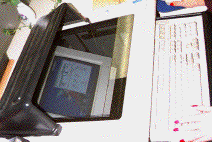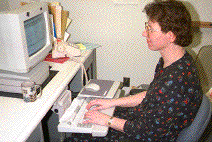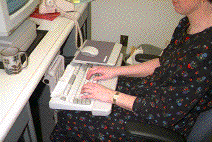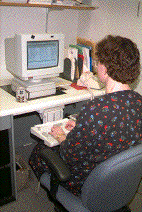
Cornell University Ergonomics Web

The Problem
WY is right handed and works most of the time on a computer. She was experiencing increasing amounts of pain in her right shoulder and wrist and discomfort in her right upper and lower arm. She had received physical therapy treatment and intermittently wore a wrist brace. An "ergonomic desk", like the one shown in Figure 1, had been purchased for her, but this did not help to resolve her symptoms. Indeed, her symptoms were continuing to worsen when she contacted the Cornell Ergonomics group for advice.
Pre-intervention Workstation Arrangement
WY worked at an "ergonomic" computer desk where her monitor was placed below the desk surface, and she viewed this through a glass panel. Her workstation was identical to that shown in figure 1 (note that we had made the changes to her desk prior to photo documenting her case, and so we photographed a colleague with an identical desk - this person was also having problems and subsequently her workstation was changed). Because the glass reflected the overhead lights and caused glare problems, she had to use a cumbersome monitor shade (see Figure 2), but this was not tremendously successful because the overhead light was behind where WY was sitting. Her monitor arrangement and glare shade effectively occupied most of her immediate work area, and paper documents had to be handled and viewed to either side of this, causing some postural twisting. Her keyboard was placed on a retractable, flat keyboard tray with a hard, narrow and uncomfortable palm rest. Her mouse had to be used on a platform to the right of the monitor (see Figure 3).
Figures 1 and 3 clearly show that this keyboard and mouse arrangement forced a working posture with the right arm extended, abducted away from the body, and with the right wrist in sustained extension. Her low monitor placement also forced her to work with her neck bent downward. Although advertised as an "ergonomically designed" computer workstation, analysis showed this arrangement could be the source of her musculoskeletal problems.
Figure 1 Pre-intervention keyboard arrangement.

 Figure 2 Pre-intervention screen glare.
Figure 2 Pre-intervention screen glare.
Figure 3 Pre-intervention mouse arrangement.

Ergonomic Intervention
From analysis of WY's working posture, we concluded that she needed a keyboard and mouse arrangement that would fit a this desk, and yet still allow her to work with her arms relaxed and within the immediate work zone, from elbow to elbow, and with her wrists sustained in a neutral posture. Office desks normally have a solid worksurface, but by placing a piece of would beneath the glass it was quite easy to refit this desk with an ergonomic keyboard system. From the options examined, we selected a Preset tilt-down keyboard system, and after installation we evaluated the effects of this system.
Post-intervention Workstation Arrangement
A piece of wood was screwed to the desk beneath the glass panel. A Preset tilt-down keyboard system was fitted to the desk
using this wood for support for the track(see Figure 4).
This system allows WY to work at her keyboard while sitting in her chair,
with her arms relaxed and her wrists in a neutral posture (Figure 5).
Figure 4 Post-intervention keyboard arrangement.

 Figure 5 Post-intervention neutral posture
keyboard arrangement.
Figure 5 Post-intervention neutral posture
keyboard arrangement.
The position adjustable mouse platform (see Figure 6) allows her to work
with her right arm relaxed, and close to the body. In this posture her right
shoulder is relaxed and her right wrist is in neutral posture. The slide
in-plane document holder allows her to work without either a twisted or
awkward neck posture, which also allows her shoulders to relax.
 Figure 6 Post-intervention mouse arrangement.
Figure 6 Post-intervention mouse arrangement.
Her computer monitor was placed on top of height adjustable monitor supports (Adjustors) to raise this to an appropriate level for relaxed viewing (Figure 7).
Figure 7 Post-intervention monitor arrangement.

Analysis of WY's new working posture with the Preset tilt-down keyboard system shows that she can now perform all of her computer work with her arms relaxed and within the immediate work zone, from elbow to elbow, and with her wrists in a neutral posture, and with her shoulders and neck relaxed (see Figures 4 and 5).
WY is now free from musculoskeletal symptoms and discomfort.
For further information on this case study contact Alan Hedge by email at ah29@cornell.edu